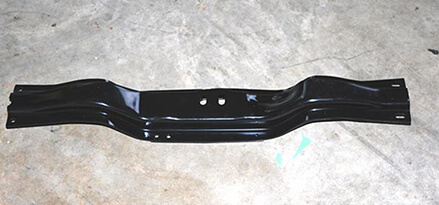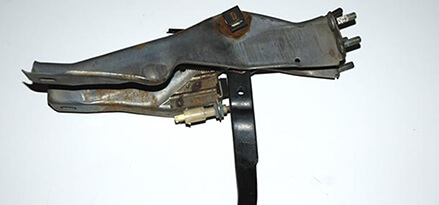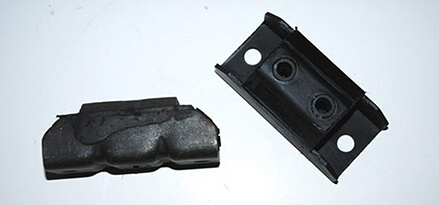By Wayne Scraba, automedia.com
Difficulty: Difficult
Estimated time: 240 minutes
What should you do when you’re stuck with an automatic transmission on your vintage muscle car, and you really want a manual? Simple. Make the swap. The big pieces are often the pedals, linkage and transmission mounts. Using a vintage, first-generation (1967-1969) Camaro and third-generation (1968-1974) Nova as examples, this article shows and tells how it’s done.
Clutch linkage
If you’re converting an automatic to manual, you could come across some seemingly impossible obstacles. Sticks weren’t nearly as common as automatics and, for the most part, wrecking yards are picked clean of usable clutch linkage hardware. However, the aftermarket has kept pace, and restoration specialists can offer complete clutch linkage kits for swapping a stick where an automatic once lived.
There’s a bigger dilemma if you’re swapping a big block, stick shift combination into a 1968-1974 Nova or 1967-1969 Camaro: A small block clutch cross shaft just doesn’t work with a big block. The additional width of the rat motor creates a small dilemma with the small block shaft. The geometry changes, and it doesn’t fit. Worse yet, shortening it and repositioning the mounts isn’t exactly simple. To make matters worse, the genuine part number (3912602 and its many changeups) has long since been discontinued.
On a brighter note, the reproduction aftermarket has tooled up with an exact replacement that both fits and works. Most parts dealers have a comprehensive big block clutch linkage kit available, and the pieces look and work just like the original (see photos).
What about the other bits and pieces? For the most part, the remaining components are generally available. Heavy-duty accessory hardware such as blow-proof bell housings and adjustable bell housing pivot balls are available, and so are clutch forks and neutral safety switch assemblies.
Pedals
What about pedals and the associated under-dash linkage? Just like the actual clutch linkage, the pedals have long been discontinued from Chevy’s stockpiles. Restoration companies come to the rescue here as well. Many automotive restoration parts dealers also offer a complete, stock replacement 1968-1972 under-dash pedal assembly. To install them, the stock automatic pedal must be removed from the steering column support and the stick shift pieces installed. It’s a simple process where a clip is removed, and the pedal shaft slides out. The automatic bits are replaced by the stick shift counterparts in reverse order. You’ll note that in this case, the clutch pedal mounts to the outside of the pedal mount. While it looks wrong, it’s not. That’s how the factory did it.
You’ll need a couple of pedal pads (available in the aftermarket). You can also buy brake pedal pads with the correct disc brake logo. Some cars came with bright, stainless pedal trim. These pieces are readily available in today’s restoration aftermarket. When installing new pedal pads, it’s a good idea to use a dab of silicone sealer as glue on the backside. It stops the pad from sliding on the pedal.
Transmission cross members and mounts
The nature of the vintage "X" bodies (Novas) as "the car for all people" proved to be more than influential in the transmission department. Because the basic vehicles were seen as anything from pedestrian econo-sedans to all-out racers, the availability of transmissions was prolific, to say the least. And the same actually applied to the "F" bodied Camaro. Everything from the Powerglide to race-inspired "rock crusher" Muncies occupied the space under the floorboards. Because of this, physically swapping gearboxes in a 1968-1974 Nova or a 1967-1969 Camaro is an easy task.
Many non-stock combinations are possible. Examples include Powerglides behind big blocks, Muncies behind straight sixes, Turbo-hydro-backed V6s and a host of others. It was almost like Chevrolet engineers envisioned the whole swapping scheme: Chevy included a number of different cross members and a series of holes drilled into the front subframe just for this purpose.
The basic cross members can be broken down into three groups: the Turbohydramatic 400 examples, non-TH400 examples and big block versions. The most difficult cross members to locate are the big block Turbo 400 models along with the big block Four Speed/HD Three Speed jobs since they are one-application components. The good news is these pieces are readily available from the aftermarket. And so are all of the other transmission cross members. In the end, you have to be sure to use the correct cross member for the appropriate transmission.
In addition, the basic transmission mount (affectionately referred to as the "mounting" in original GM parts catalogs) is similar for all examples. Aftermarket solid versions are available, but it has been our experience that these pieces are best left to the drag race-only crowd. Coupled with solid motor mounts, these parts have a tendency to bind the entire powertrain together too tightly. The result is often broken mount ears on four speed cases or completely fractured case assemblies on automatics. Stick with the OE-style rubber hardware. Your transmission will be much happier, and the restoration aftermarket has a full complement of replacement transmission mountings.
As you can see, swapping to a stick in a vintage car is generally a straightforward operation. You just have to know what fits what. For a closer look, see the accompanying photos.
-

This is a reproduction big block four-speed transmission cross member for a first-generation Camaro or a third-generation Nova. In the case of a big block, the engine and transmission are actually offset slightly to gain clearance. As a result, transmission cross members differ between big and small block cars.





